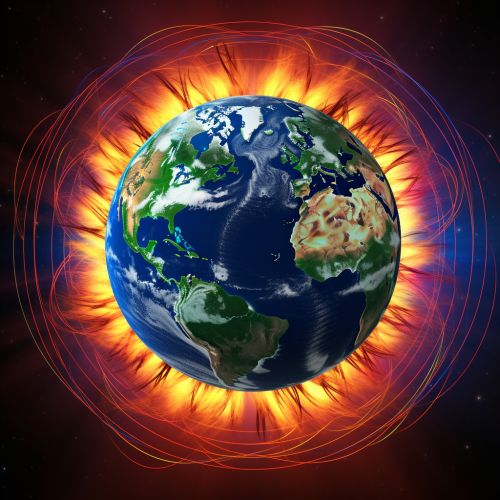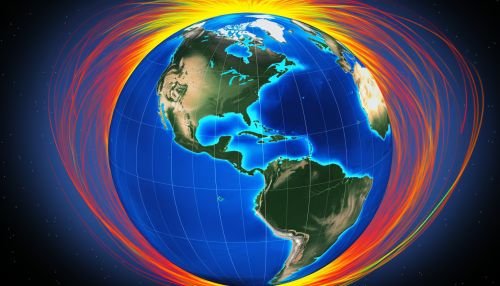Geomagnetism
Introduction
Geomagnetism is the study of the Earth's magnetic field, a complex and dynamic force that extends from the Earth's interior into space. This field is primarily generated by the motion of molten iron within the Earth's outer core, a process known as the geodynamo. The Earth's magnetic field is crucial for life on Earth, as it shields the planet from harmful solar radiation and aids in navigation for many species.


History of Geomagnetism
The study of geomagnetism has a long history, dating back to ancient times when people first discovered the magnetic properties of certain minerals, such as lodestone. In the 16th century, William Gilbert, an English physician, published "De Magnete," a comprehensive study of magnetism. Gilbert was the first to suggest that the Earth itself is a giant magnet.
In the 19th century, the development of the magnetometer allowed for more precise measurements of the Earth's magnetic field. This led to the discovery of magnetic anomalies and the realization that the Earth's magnetic field changes over time, a phenomenon known as geomagnetic secular variation.
Earth's Magnetic Field
The Earth's magnetic field is a complex entity, with its strength and direction varying across the Earth's surface and changing over time. The main component of the field, known as the main field, is generated by convective motion in the Earth's outer core. This motion is driven by heat from radioactive decay in the core and from the mantle above.
The main field is approximately a dipole, meaning it has two poles, north and south, similar to a bar magnet. However, there are also smaller, more complex components of the field, known as the crustal and external fields. The crustal field is generated by magnetized rocks in the Earth's crust, while the external field is generated by electric currents in the ionosphere and magnetosphere.
Geodynamo Theory
The geodynamo theory explains how the Earth's magnetic field is generated. According to this theory, the motion of molten iron within the Earth's outer core generates electric currents, which in turn produce the magnetic field. This process is driven by convection, with heat from the core and mantle causing the molten iron to move in a circular pattern.
The geodynamo theory also explains why the Earth's magnetic field changes over time. Changes in the flow of the molten iron can lead to changes in the electric currents and thus changes in the magnetic field. This can result in geomagnetic secular variation and even complete reversals of the magnetic field, known as geomagnetic reversals.
Geomagnetic Reversals
Geomagnetic reversals are times when the Earth's magnetic field flips, with the north and south magnetic poles switching places. These reversals have occurred many times throughout Earth's history, with the last one occurring approximately 780,000 years ago.
The process of a geomagnetic reversal is not fully understood, but it is believed to be related to changes in the flow of the molten iron in the Earth's outer core. During a reversal, the magnetic field weakens, becomes complex, and then strengthens again with the poles in the opposite positions.
Geomagnetic Secular Variation
Geomagnetic secular variation refers to the slow, gradual changes in the Earth's magnetic field over time. These changes are caused by the motion of the molten iron in the Earth's outer core.
Secular variation can cause changes in the strength and direction of the magnetic field. Over the course of hundreds to thousands of years, these changes can result in significant shifts in the magnetic poles.
Magnetic Anomalies
Magnetic anomalies are areas where the Earth's magnetic field is significantly different from what would be expected based on the main field. These anomalies can be caused by a variety of factors, including variations in the Earth's crust, such as the presence of magnetized rocks, and external influences, such as electric currents in the ionosphere and magnetosphere.
Magnetic anomalies can have important implications for a variety of fields, including geology, archaeology, and oil exploration. For example, they can be used to detect underground structures or deposits, such as archaeological sites or oil reserves.
Applications of Geomagnetism
The study of geomagnetism has a wide range of applications. One of the most well-known is navigation. For centuries, sailors have used the Earth's magnetic field to navigate the seas, and many animals, including birds and sea turtles, also use the magnetic field to navigate during migration.
In addition, geomagnetism plays a crucial role in protecting the Earth from harmful solar radiation. The Earth's magnetic field deflects charged particles from the sun, preventing them from reaching the Earth's surface. This is particularly important during solar storms, when the number of charged particles can significantly increase.
Finally, the study of geomagnetism can provide valuable insights into the Earth's interior. By studying variations in the magnetic field, scientists can learn about the structure and composition of the Earth's core and mantle, as well as the processes that occur within them.
